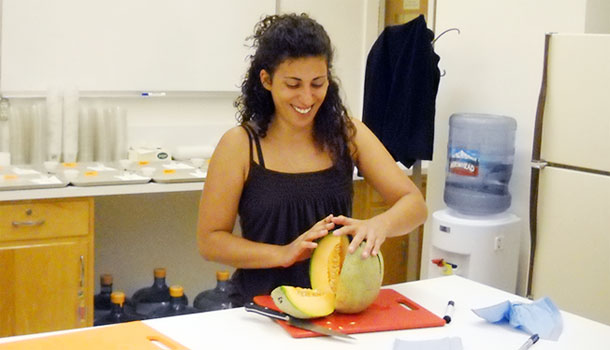
'Artificial nose' knows the ripeness of fruit
Thursday 24 May 2012
UC Davis researchers are applying the same science used to sniff out illegal drugs to smelling and picking out the freshest melons.
Drug-sniffing dogs are common at U.S. airports. But only 30 percent of dogs have noses that are sensitive enough to qualify for this work, and various countries have come up with their own solutions to that problem. In South Korea, officials cloned their top sniffer, a Labrador retriever named Chase, and every one of Chase’s clones has his remarkable nose.
American law enforcement officials took a high-tech approach. They use portable, highly sensitive gas chromatography — a technology to separate and analyze compounds — to smoke out drug smugglers and potential bomb throwers.
As it turns out, a gas chromatograph can also stand in for an Italian grandmother.
Simona Vallone (in photo in her lab above), a UC Davis postdoctoral researcher, is part of a team of scientists finding ways that gas chromatography can be combined with newer technologies to assess the ripeness of fruit. The goal is to improve American eating habits by making supermarket produce as full of flavor and scent as the food Vallone remembers from her childhood in Naples, Italy.
“I grew up in a situation where I was able to eat fruits and vegetables that were no more than a day old,” she said. “We had stands where my mom and my grandma would buy fruits and vegetables. You could find produce that had just peaked. There was better quality and better flavor.”
Many Americans grew up on standard supermarket produce, and that meant tasteless tomatoes sometimes sprayed with a liberal amount of chemicals and picked while they were still green so they would have a longer shelf life. Only in the last decade or two, as food co-ops and farmers markets have spread across the country, did many people learn to appreciate the flavor of a peach or a tomato the way their grandparents did.
In Italy, Vallone watched the process in reverse as agribusiness began to take the place of the farmer pruning his family’s vines under the golden Mediterranean sun.
“Unfortunately, the romantic image of Italy isn’t entirely real,” Vallone laughed. “I grew up in that situation, with farmers getting their produce to small markets. As the market became bigger, things changed. Handling that large amount of produce makes it impossible to have such a short chain from grower to distribution, so that means longer handling and storing produce in cold rooms, which also affects flavor. I know both sides from Italy.”
Vallone remembers her mother and grandmother squeezing melons and holding them up to their noses, searching for the tell-tale scent that says, “Now.”
This is one reason she is using an experimental device called the “artificial nose.” It’s actually named the “zNose” and made by the company, Electronic Sensor Technology.
In Vallone’s research — she’s concentrating on melons — that means getting information about volatile compounds that create an aroma. To analyze aromas from fruit, the research team team, which includes scientists from the USDA, UC Davis Department of Food Science and Technology, and the University of Florida Citrus Research and Education Center, combined ultra-fast gas chromatography with a state-of-the-art surface acoustic wave sensor that dramatically speeds up the testing process.
Vallone and others in the team recently published their research, “Fruit Volatile Analysis Using an Electronic Nose,” in the Journal of Visualized Experiments.
Their work is part of a multi-state project funded by the U.S. Department of Agriculture and several companies, including Harris Moran, a California-based subsidiary of a multinational agricultural cooperative run by French farmers. Their goal is to identify varieties of produce with longer shelf lives and more flavor.
Vallone, who first came to UC Davis as a visiting Ph.D. student from the University of Naples, is working with professor Florence Zakharov in the Plant Sciences Department and Susan Ebeler in the Viticulture and Enology Department.
“It’s a big improvement,” said Vallone about using the artificial nose. “It’s not only faster, but much cheaper and requires less training. It’s also portable. One of the things we were thinking is that people could bring it into the field to detect ripeness at harvest time.”
Vallone and other members of the lab are still analyzing the results from testing the technology in the field last summer. The artificial nose still detects fewer compounds than traditional gas chromatography, so more work might be needed before it can be used commercially.
With more than 100 compounds combining to produce the sweet, evocative scents of melons in the summer, Vallone admits that technology hasn’t quite caught up with nature — or with her grandmother.